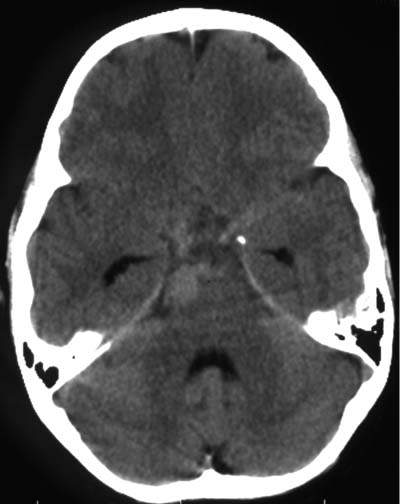22 Diagnosis Giant AICA aneurysm Problems and Tactics A 6-year-old boy presented with subarachnoid hemorrhage from a giant anterior inferior cerebellar artery (AICA) aneurysm. Cardiac standstill1–3 was employed with a retrosigmoid approach to expose and deflate the giant AICA aneurysm. Keywords Giant AICA aneurysm, cardiac arrest, hypothermia A 6-year-old boy presented with the acute onset of headache, nausea, and vomiting. Computed tomography of the head demonstrated subarachnoid hemorrhage in the basal cisterns (Fig. 22–1). Cerebral angiography demonstrated a giant AICA aneurysm (Fig. 22–2). General anesthesia was induced. Under sterile technique a right frontal ventriculostomy was placed to drain cerebrospinal fluid during the procedure. The patient was placed supine and was placed in a three-point fixation in a headholder. Baseline somatosensory evoked potentials, electroencephalography, and brain stem auditory evoked potentials were monitored. The right side of the head and the groin were prepared in the standard sterile fashion. A right-sided retrosigmoid approach was performed and the surgical microscope was brought into the field. The dura was opened and microsurgical dissection was performed to expose the cerebellopontine angle. The arachnoid was dissected sharply to expose the seventh and eighth cranial nerves and the ninth and tenth cranial nerves below. The ectatic basilar artery and the giant aneurysm arising just above the AICA and projecting rostrally were visualized. It became evident that the aneurysm’s neck could not be fully exposed without cardiac standstill. A cardiac surgeon therefore cannulated the patient’s femoral artery and vein and began the cardiac standstill and cooling process. The patient was placed under barbiturate burst suppression, and complete cardiac standstill was achieved with his core body temperature lowered to 20 °C. The aneurysm was deflated, which allowed exposure of the proximal and distal basilar arteries and excellent exposure of the neck of the aneurysm. Both AICAs were identified, and the ipsilateral sixth cranial nerve was dissected free from the base of the aneurysm. The aneurysm was clipped with an 11-mm curved and a 15-mm straight titanium aneurysm clip. The pump was restarted and the aneurysm dome did not refill. The length of cardiac standstill was 14 minutes. FIGURE 22–1 Axial computed tomographic scan of the head shows subarachnoid hemorrhage in the basilar cisterns. The patient was slowly rewarmed and his heart restarted. The wound was closed by replacing the bone flap with microplates and screws. The skin was closed in a layered fashion. Postoperative angiography showed complete obliteration of the aneurysm with preservation of the basilar trunk and AICAs (Fig. 22–3). The patient developed hydrocephalus and required placement of a ventriculoperitoneal shunt and treatment for a shunt infection. The patient was transferred to neurorehabilitation and recovered to his preoperative neurological baseline. He was discharged to home.
Giant Anterior Inferior Cerebellar Artery Aneurysm in a 6-Year-Old Boy Treated with Hypothermic Cardiac Arrest
Clinical Presentation
Surgical Technique
Outcome
Key Points
Stay updated, free articles. Join our Telegram channel

Full access? Get Clinical Tree









